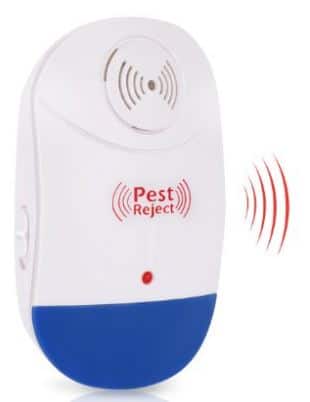Table of Contents
It’s hard to find a scenario more discomforting than knowing you have mice and rats overrunning your home. Humans have always had an aversion to these rodents, and with good reason. They carry a host of diseases – not least of which in history was the Black Death or bubonic plague. Not only that, but they eat your food, leave droppings everywhere, chew on wires, and build nests out of the insulation. Overall, they simply aren’t wanted.
There are several ways to get rid of them. You might be tempted to try using an ultrasonic pest repellent to drive the mice and rats away because you don’t want to kill them or deal with finding their bodies under a cabinet. Ultrasonic pest repellants, unfortunately, don’t work.

Field Mouse taken by Martyn Fletcher. Licensed Under CC by 2,0
How Are Ultrasonic Pest Repellers Supposed to Work?
These gadgets are supposed to emit a sound that only rodents can hear, and the sound is supposed to make them uncomfortable to the point of leaving the area. Ultrasonic pest repellers or repellents may be used as pest control but there’s so much to this than meets the eye. Ideally, humans can’t hear this sound, but as we all know, things are never ideal.
Why Don’t Ultrasonic Repellers Work?
Ultrasonic pest repellers may seem like nifty gadgets, but they fall short for a few reasons. First, mice tend to only get startled by the sound for a few days or so. Once they get used to the sound, if other aspects of your home are good enough for them they will brave it and continue to live there.
Secondly, ultrasonic frequencies only have a short range. The higher the frequency of any wave, light, or sound, the more easily disrupted it is and the shorter effective distance it has. In other words, ultrasonic waves at high frequencies can be blocked by any number of foreign objects you have in the area.
Thirdly, many of the repellers work by plugging into a wall outlet. This obviously limits where you can put them unless you’re willing to run extension cords into random spots in your house. Mice can quickly learn to avoid where the sounds are coming from and proceed along their way through your house.
For more information about this and the lawsuits that have developed, please read Do Ultrasonic Repellents Work On Mice.
However, this isn’t the worst of it. You may ask, are ultrasonic pest repellers safe for humans? The short answer – ultrasonic pest repeller dangers humans and pets as well!
Ultrasonic Pest Repeller Side Effects & Dangers
Even though the sound of an ultrasonic emitter is supposed to affect only rodents, some animals can hear the sounds; for example, some breeds of dogs can hear it. It makes them highly uncomfortable.
On humans, the effect can be worse. Some people actually can hear sounds above the normal range of hearing, though this ability drops with age. Furthermore, a link does exist between ultrasound and various effects on hearing, even if the person cannot consciously hear. The frequency can produce vibrations in the inner ear and the brain. The results can be feelings of nausea, disorientation, fatigue, and migraines.
This doesn’t happen all the time, but it can happen, especially with prolonged exposure and to those with sensitive hearing. Sound is the vibration of air molecules. At certain frequencies, it has certain effects, like an opera singer being able to shatter glass at the right pitch. The same concept applies.
So How Do You Stop Mice?
Some people have tried to use non-sonic rat repellents, but these aren’t always effective either. The idea of using a particular scent seems odd. Mice are used to strong odors, so using a peppermint spray or similar product doesn’t necessarily work. In some cases, when paired with other methods of getting rid of rodents, they can help. Used alone, it isn’t likely they will do much.
In extreme cases, you’ll need to bring in an exterminator. An exterminator will inspect your house, let you know where the likely entry points are, and deploy poisons, traps, and other means to kill the mice so they no longer bother you. The best rat exterminators should be able to handle your problem in no more than four visits.
If the exterminator tries to get you to agree to a service contract over a certain amount of time, look elsewhere. Also, see if the exterminator will perform cleanup services. Your attic is the most likely place where mice and rats will make their nests because of all the insulation.





